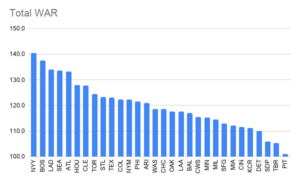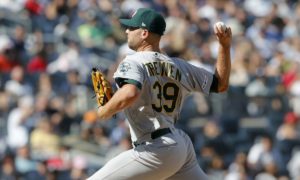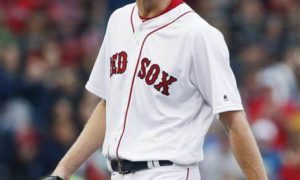Confucianism Baseball: A WAR League Adventure

Confucius, the famed fifth century B.C. Chinese philosopher and baseball strategist, once said, “True wisdom is knowing what you don’t know.”
This season, I have the opportunity to participate in one of the baseball Internet’s coolest fantasy leagues. The WAR League’s elegance is in its simplicity. 50 teams select four players each in a snake draft, for which there is only one category: WAR (specifically the Baseball-Reference version, or bWAR). The team whose quartet of players accumulates the most WAR in 2019 is the winner.
The WAR League was created by @MLBRandomStats and @bearcub712, and they do an excellent job managing the draft. There are four divisions named after Babe Ruth, Barry Bonds, Willie Mays, and Ty Cobb. You can view the entire league on this spreadsheet.
I picked 19th overall in the Cobb Division, which was the last division to start drafting. This gave me an opportunity to follow the advice of Confucius. I’d like to think I know a decent amount about baseball, but I am aware that there is much more that I don’t know. The game is simply too massive, complex, and random for anyone to claim mastery. Given the understanding of my own insufficiency, I decided to let the rest of the league make my picks for me (sort of).
I created a spreadsheet that mirrored the shared one for the league. In my own sheet, I calculated the average draft position (ADP) for each player. When it was my turn to pick, I simply drafted the player who had the highest ADP from the other three divisions, but was still undrafted in my own.
Handling over the controls to a formula was relieving, yet unnerving at the same time. You can view my ADP spreadsheet here. Below is the description of each pick.
Pick #1
With my first selection, I was fortunate to select the player with the eighth highest ADP in the draft: Chris Sale. When healthy, Sale is the best pitcher in the American League, and maybe in all of baseball. His 1.98 FIP and 13.5 K/9 were the best in MLB last year (minimum 150 IP). That parenthetical innings caveat is the problem though. With a violent motion, he spent time on the shelf last season, then returned with diminished velocity. September fades are common for him.
This is nitpicking, really. Sale is an elite pitcher. However, I would have preferred a position player, as they’re generally less volatile. If left to my own devices, I would have picked Anthony Rendon. Sale’s ADP was 8.67 compared to Rendon’s 18.67, so sticking to my plan gave me the better bargain with the 19th overall pick.
Pick #2
With the 82nd overall selection, my ADP calculations granted me Kyle Freeland. I’m not happy about this. Freeland had a fantastic year for the Rockies in 2018, but it was quite unexpected. His 8.4 WAR was fourth best in the National League last year, but odds are he won’t be able to replicate that success. I’ve seen enough Colorado pitchers falter and fade to have any faith in a popup ace like Freeland.
Making this even more difficult to swallow, Freeland’s 58.67 ADP was scarcely ahead of James Paxton‘s 59.33. Freeland was selected 79th, 73rd, and 24th in the other three divisions, so I’m forced to pick him because someone in the Mays Division jumped the gun. I would have rather chosen Paxton, and thought about breaking my self-imposed rules to grab him. Alas, I did not.
Pick #3
Through the first two rounds, there were very few outliers. Most of the same players were picked in the top 100 in all four divisions. In the third round, things spaced out considerably, and individual preferences became a larger factor. This had a major impact on the ADP, as well as my own selections.
I drafted Miles Mikolas with the 119th overall pick. There were nine other players with a higher partial ADP, but had not been selected in all three of the other divisions. Nevertheless, I’m happy with the pick. The Cardinals starter led the league with 1.3 BB/9 last year, throwing 200 2/3 innings.
Mikolas was probably the best player available, but given my preference for position players, I wasn’t thrilled to draft a third pitcher. Instead, I would have chosen Justin Upton, even though his 115.67 ADP was significantly lower than Mikolas’ 97.67.
Pick #4
Confucius was an idiot. He made me draft a reliever.
With the 182nd pick, Blake Treinen had the highest ADP of the available players: 102.0. Treinen was the best reliever in baseball last year, amassing 4.3 WAR. However, in his previous four seasons his WARs were 1.0, 0.2, 2.0, and 1.3. It’s very unlikely that he’s one of the 200 best players in baseball in 2019.
Rather, Marwin Gonzalez would have been a safer pick. The Twins’ new superutility man was drafted 119th in the Ruth Division and 44th in the Mays, but not at all in the Bonds. My rules dictate I had to pass him by.
Overall, I’m pretty happy with my team, despite having four pitchers. Steamer projects my roster to collect 13.2 WAR, which is a little higher than the average. That being said, the Rendon/Paxton/Upton/Gonzalez team I would’ve drafted on my own projects for 13.7 WAR. By season’s end, we’ll know who has the sharper baseball mind: me or Confucius.


















